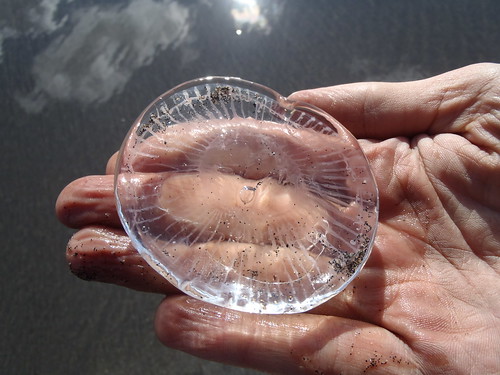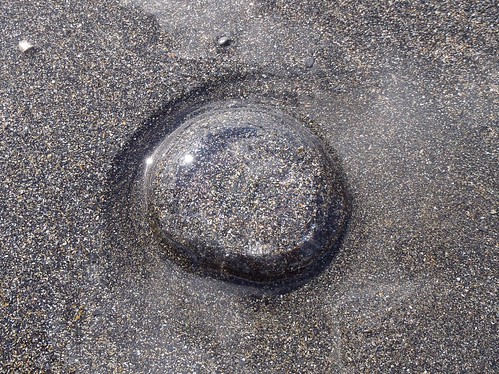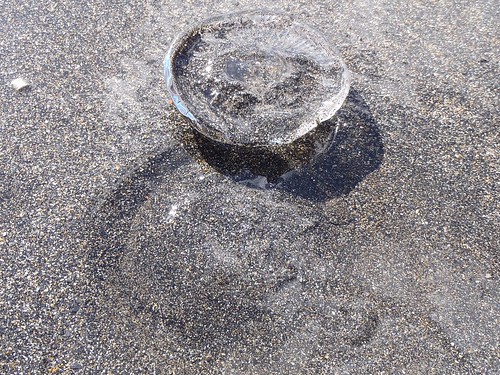One of the nice things about being a palaeontologist is that fun things quite often qualify as work. For example, a trip to the beach offers an opportunity to make observations on modern marine ecosystems and examine natural taphonomic experiments. To anyone else this may look like peering into rock pools, picking up seaweed and carefully turning over rotting jellyfish, but we know better.
We recently visited Abereiddy Bay in South Wales. I have wanted to go there for a long time, because it’s a very famous site for graptolites. Not only does it have fossils, but also public toilets, interesting insects, rock pools, dead jellyfish and a van selling snacks. This makes it an ideal field location, the only difficulty being deciding what to look at first. We started with the insects, moved on to the fossils, then the snack van, then rock pools, then more fossils, and finally walked along the sandy part of the beach to look at the jellyfish.
Jellyfish, being about as soft-bodied as it is possible to be, aren't common in the fossil record. Most palaeontologists never find one in their entire careers! Seeing the dead jellyfish strewn around the beach, we decided to see look at the impressions they had left in the sand, in the hope of being able to recognise similar structures in the fossil record.
This is the jellyfish itself, or what is left of it. The tentacles are gone (eaten or rotted away), but the bell is more or less intact. (This photo was taken after we had examined the impression it had left in the sand.)
Tuesday 23 October 2012
Jellyfish taphonomy
Jellyfish taphonomy
This is the jellyfish as we found it on the beach - note that it's oriented with the flat side down, and the retreating tide has left it in a little hollow. You might expect that there would be some recognisable imprint in the sand underneath, perhaps showing the mouth.
Jellyfish taphonomy
This is the actual impression that the jellyfish left on the sand after Joe carefully turned it over. Note the complete lack of any recognisable features. All the other jellyfish that we looked at showed the same thing. This would seem to indicate that, even if an impression of a jellyfish were to make it into the fossil record, it would not be recognisable.
Of course, these were only a few examples, and we might just have been unlucky. Perhaps other jellyfish are more obliging? Back in Nanjing, I went to the library for information on what happens to jellyfish after they die, and found a book chapter written by David Bruton in 1991. He found that the animals can leave well-defined impressions on sand, but only if they dry out, for example if they are thrown up above the high tide line. This explains why the Abereiddy jellyfish didn’t leave any recognisable marks: they were below the tide line and the sand was too wet.
So, what does this mean for the fossil record? If jellyfish do have the potential to be fossilised, but only above the high tide line, how likely is it that any of them will in fact become fossils? Graham Young of the Manitoba Museum and James Hagadorn of the Denver Museum of Nature and Science recently wrote a review of jellyfish fossils. Their paper is ten pages long, which gives you an idea of just how rare these things are, and they listed nine deposits worldwide as containing bona fide jellyfish. (There are more than nine published reports of fossils purporting to be jellyfish, but most of these cannot be confirmed as such – think how unjellyfishlike a genuine jellyfish impression can be...) Most of the jellyfish-bearing rocks were laid down in very shallow water, as expected, but some jellyfish have been preserved in deeper water. So, jellyfish can be fossilised in a variety of circumstances, but recognising them might be difficult.
And why are we so interested in this? Now that would be telling...
References
Bruton, D.L., 1991. Beach and laboratory experiments with the jellyfish Aurelia and remarks on some fossil “medusoid” traces. In: Simonetta, A.M. & Conway Morris, S. (eds) The early evolution of Metazoa and the significance of problematic taxa. Cambridge University Press, Cambridge. 125-129.
Young, G.A. & Hagadorn, J.W., 2010. The fossil record of cnidarian medusa. Palaeoworld, 19, 212-221.
Saturday 6 October 2012
Back in Nanjing
I took this photo in the evening from the office opposite ours - our office has a fine view of the wall of the badminton court. The view is of the tower of the Buddhist temple next door to the institute. Having the temple next door is quite handy from our point of view, as we can buy vegetarian dumplings or noodles at lunchtime, go to the other restaurant for an occasional evening meal, and buy interesting fake meats at one of the temple shops. (The other temple shops sell jade, incense, candles and religious figurines. Buddhist monks and nuns might not be allowed money, but they can certainly run a successful business.)
September's fieldwork was quite eventful, with some extremely interesting finds. We have to keep quiet about them for a bit (it's a condition of the grant we got from National Geographic), but will be able to share them in due course.
And we will try to post on here more often...




